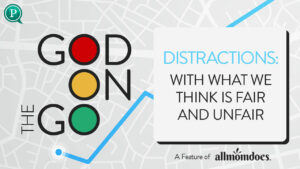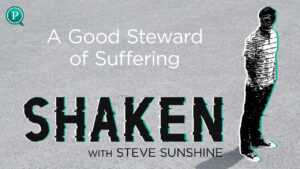The START HERE series is designed to get you the information you need to raise healthy kids in a tech world. Today we discuss the two types of tech our children will use, and how to know if that tech is healthy.
Transcription:
Nathan Sutherland:
Hello everyone, and welcome to the Gospel Tech Podcast. My name is Nathan Sutherland, and this podcast is dedicated to helping families love God and use tech. Today, we are beginning our Start Here series. This is the 2024 edition. This is where we run through each of the major topics that parents ask about all the time, that make the core of the workshops that I run, for the most part, and will help us have a firm foundation for how do we talk about technology, how do we equip families, and equip our young people to use tech on purpose, not for purpose? And then how do we clearly communicate the gospel? How do we help our children understand, and how do we understand ourselves? This idea that we are new creations in Christ, and that should affect the way we use our tech. That’s going to be the overarching theme of this conversation, but today we are starting with part one of the Start Here series: the two kinds of tech, and how do we know if it’s healthy? With no further ado, let’s get this conversation started.
We are starting today with talking about how do we know the two kinds of tech, and how do we know if it’s healthy? Two kinds of tech. There’s Tool Tech, and there’s Drool Tech. This is not good and bad tech, but this is technology that we use to create, that’s Tool Tech helps us create, and tech that we use to consume, Drool Tech. And that is important because they’re designed differently. Tool Tech wants to help you do your job better. If you want to write a paper, you’re going to use something like Microsoft Word, or Mac Pages, or Google Docs. You’re going to use something that helps you type your words out and save it to multiple locations, and even get editors from around the world. It’s very useful for writing, and for collaboration, and for creating ideas with words.
Similarly, if you wanted to make something in three dimensions, you might use AutoCAD, or you might use a program that ties in with your 3D printer, or you might use some form of the Unreal Engine for creating a game or a digital environment. That’s you creating. You can’t get overstimulated, it stops working when you stop working, and it never gives you any behavioral loops to build a habit of using this product.
Compare that to something like Drool Tech would be, say, the shows you watch. You probably use streaming services. Unless you’re putting a DVD in a DVD player, which a lot of our computers don’t even come with those anymore. But unless you’re doing that, you’re probably using a streaming service. That streaming service is built for retention. It’s built to keep your eyes. It wants to take your time, your focus and your money. You’re probably paying a monthly subscription. Then when you go to watch the show you want to watch instead of saying, oh, do you want to just watch another of this? It’s going to say, hey, what about these 10 other shows that are like that? Or these thousand other shows that aren’t really like that, but they’re somewhat related, maybe you want to check them out.
Instead, it wants you to click on shows you’ve never watched before, stay a little bit longer, try out 10 of them for maybe only 10 minutes a piece, what are you out? And the idea is they’re expanding your appetite for it in order to take, again, your time, they want you to stay longer than you intended to, your focus, they want you to come back more often than you intended to, and your money. And the second one, the reason focus and time are important is because if they can get you in one big, I guess, bolus of time, that’s great. But that’s not always the way it works, and YouTube is a great example of this.
YouTube, if they could get 1% of their two and a half billion monthly users to stay just one minute extra, 1% of their users, so everyone’s coming on and they’re using it to find out how to fix their air conditioner, how to do that do-it-yourself project. I’m working on shelf project right now. So how to do that shelf, cool. We’re going to watch that eight minute video, and they made it really nice now. You can go just to that one part of the video, you can skip the intro and get to two minutes and 13 seconds where they start talking about that one part about laying the shelves in. Cool. But then a suggested video comes up and it’s like, oh, I don’t know, how did that bike racer make it down that hill so fast? Or how did that squirrel make it through that maze? I’m going to click on that. If you just stay for one minute, and you’re only 1% of their users, they gain more than 18,000 days of viewing that month.
Now, that’s a big number, so let’s break that down into context. That’s enough time to watch all 10 seasons of Friends 343,000 times. That’s how much time they gain from 1% staying one minute. That’s really, really important, because that shows the incentive behind Drool Tech. If you’re like, but why would anyone make Drool Tech? Because it makes a lot of money.
Another example, Fortnite. Fortnite is a free to play video game, meaning you can go download it for free on your phone, you can download it onto your computer, and you can play it for free. That’s it. You can just show up, you’ll have one of two character options. You can just go play with everybody else. And there’s no trial subscription, you’re in there, no credit card due, you just play it. But the game makes five and a half billion dollars a year. How? Because of microtransactions. Because they get you invested in the game, and once you’re invested in the game, you’re like, well, I already spend so much time here. It would be cool to have a character I like looking at more. Or I would like to have this thing that my friends think is cool, or I’d like to have a thing that shows that I’m really invested and this is part of who I am.
And enough people believe that, that a free to play game makes five and a half billion dollars year. And by the way, they’re not stopping to showing you ads all the time. There’s other things they sell subscriptions to… Anyway, there’s other stuff, but microtransactions are at the heart of it. They want to take your time, your focus and your money. They don’t just want to provide you a fun game to play, they want to make an incredible amount of revenue off of that. And Drool Tech is really, really good at bringing in revenue.
That’s why there’s a huge difference between Microsoft Word, Tool Tech, huge difference. Microsoft Word, iMovie, AutoCAD, Python, any of these coding, programming, design, if it’s you putting in the work and this thing’s just helping you do it better. I’m much faster typing than I am with writing with a pen, and it’s much better than having to mail a manuscript to somebody. I actually have a manuscript that I’ve got final edits due on, and it was just sent to my email. It’s great. Thank you, Tool Tech.
Now, can you misuse Tool Tech? Yes. Parents, please hear this. It’s usually us that misuse this, but young people can too. You can get so focused on a project that’s good, it’s Tool Tech, you’re designing and creating, but now you’re starting to get identity from it, and you’re getting lost in it, and other things are starting to fall off the table, or other responsibilities are starting to waste away because you’re not giving it the focus it deserves. That’s also problematic, but it’s not because of the design of that product. That’s a heart issue.
I’ve misused email before. I’ve even, I’ve mentioned it before on the podcast, but I’ve snuck it on vacation before and had to repent. Because I felt really important, and this project, this next job, this next thing, this person that needs me, I have to get back to that, obviously, on a family vacation that is designed to… some family vacations may be working vacations. This was not, this was supposed to just be family. That’s a Nathan issue. That wasn’t because Outlook kept sending me notifications. I have all my notifications turned off. I never get any little red circles that show up, or Outlook has never sent me a notice to ask me to come hang out. It was just a me issue. So keep that in mind, you can misuse Tool Tech, but it’s usually an internal problem with us. Drool Tech is trying to build some of those unhealthy habits.
That brings us to then, the health part. As a loving parent, you want to make sure that you’re giving your child great gifts. They ask you for an egg, you want to make sure you hand them an egg, not a scorpion. You want to give them something that is going to help them grow, and be strong, and become more of who they’re designed to be, not distract them, or harm them, or otherwise way waylay them from their path that God has got them on. So how do we know? We know it’s tool or drool.
And by the way, before I move on with that, I do want to address, you can have tool and Drool Tech on just everyday technology. Kids as young as five and six can understand the idea of this is Tool Tech. This is helping you create, what can we create with this? And make it an adventure, and make it an exploratory thing. Doesn’t mean it’s going to be good on their first time. It just means it’s creating, and the creative act itself, I would argue, is good. It’s part of what we’re made for. We see God do it throughout all of both the creative process, and then history. He keeps creating, and bringing to life, and bringing hope and restoration, and He will create again. So we’re looking forward to that, come on, Revelation. But until that day, it’s part of our image bearers of God thing. We create, and that’s beautiful.
And so we can use that with our kids. What can we use to create? What do we want to make? How can we use this technology well? And they can also understand the Drool Tech side of, hey, we’re going to watch a show, and we’re going to use that. My own children use Drool Tech services to watch the shows we like. And we can point out, my kids all know, hey, when we log in here and we’re going to go watch our show. What are we going to see? We’re going to see ads, and we’re going to see 10,000 videos that we didn’t ask to see. We know what we watch, we watch roughly three shows. We watch Daniel Tiger, Super Y and Wild Kratts. Sprinkle in some Dude Perfect every once in a while, but that’s not all that’s going to pop up. Tons of other unrelated things are going to pop up, because they want our time, focus and money.
We’re just going to say it simply, hey, we’re going to watch one or two episodes. We’re going to enjoy it for X amount of time, and then we’re going to go have another adventure. Keep that in your brain. Because when this ends, it is very normal to just feel bummed, because it was so fun. It’s seamless, effortless, frictionless fun. It takes no work to have fun with Drool Tech, because all the work is done for you. There were entire teams of people that made that video easy to watch, that made that game easy to play and enjoy, that made that social media platform so scintillating, and the feed so engaging. That’s literally trillion-dollar companies’ jobs, is to make that work. So what are we going to do next? And remember that there’s a next. This isn’t where we stop. This is something we do, we enjoy, and we move on. Why? Because it’s got hooks. It’s sticky. It builds behavioral habits without us even having to think about it, and we want to be attentive to that.
My kids understand that. Your kids, my kids are 10, eight and four, you can do the same thing with your kids. You can have that conversation, hey, this is Drool Tech, it’s going to help us enjoy a fun show, and then we’re going to walk away. Because sometimes it wants us to stay longer than we should, and we need to recognize that, then just move on. Talk about it, this is amazing, we’re going to enjoy it. Let’s make sure we move back. The other thing we’re going to talk about is if someone gets upset, be like, hey, I get it. That is really fun, but we can’t let that be our only fun, so let’s go try something new. Let’s go practice something, let’s go make something, and have that be fun too.
And this is where analog adventures, parents, when we’re dealing with Drool Tech, this is where analog adventures are so, so helpful. Analog adventures are the fun that we practice in real life because real life fun takes work. If you have Tool Tech and Drool Tech, Drool Tech has all of the exploratory pieces and all the creative elements baked into it in a way that’s so accessible, it requires no initiative on your side. It’s just right there. It’s got quests, it’s got levels, it’s got points, it’s got colors, it’s got sound effects. Everything rewards you for just participating with your environment. Real life doesn’t. You don’t pick up a block and it goes, woo-hoo, right? Maybe if it’s some kind of electronic block, it might. And that will be a thing one day. Please don’t make that based on this suggestion, you’re ruining blocks.
But there’s something like, I built a block and I put it together, and maybe there’s some kind of a reward to that. But maybe there’s not, and I actually have to get the whole building, and then I feel a sense of reward. Or I have to start playing with it with a story, and then I get a sense of reward. But it takes work. It requires time, and focus, and repetition. And those are the things, by the way, that those games, and social media platforms, and streaming devices or apps all have baked in. What was the last thing I just said? They have the, oh, repetition baked in. The behavioral training to get good at that thing is part of how they do it with, again, I mentioned levels, feeds, scroll to refresh. Or the pull to refresh, excuse me. Infinite scroll, likes and followers, points, the colors, the sound effects. All of those are things that reward you so that you’re now more invested, so that you’re more likely to participate the next time you get the urge. We’ve got to work on that.
Some favorites from this time of year from my family, we love puzzles. Specifically, if you want an easy one, we go 300 piece puzzles, we like the Star Wars ones from Buffalo Games. Not sponsored, I just like them. They also make some great animal ones. There’s a shark one out there, and some other, dinosaurs. But 300 piece is hard enough that it takes you some time to think, but not so hard that you hate yourself. 500 pieces is a great intermediate, and a thousand plus is certainly out there for those of you that are just amazing spatial reasoners. If you’re great at that, awesome. If you’re not, 300 pieces is plenty. You can still do it. Start with the edges, people. Start with the edges.
Then you can go to board games too. My kids just got the Dude Perfect board game, which is like Monopoly with a twist. But you can play it with, I would say six and up, certainly eight and up, but it’s Monopoly with some mini-games tied in. It’s fun. Actually a couple family members apparently got it for Christmas, I ended up winning first round. And that’s important, because while I love board games, I lose all the time. I ended up winning, so two bonuses for that game. But another one that you should look into if you’re looking for just a simple game to play with your family, Taco Cat Goat Cheese Pizza. That’s the name of the game. It’s a card game, you’ll thank me. Just buy it and read the rules, and it’s silly, and ridiculously hard, and fun if you like games that… it’s kind of like spoons, but with cards, if you’ve ever played spoons. If you haven’t played spoons, it was a terrible example and just go get the game.
But you can play these, these are analog. They happen at the pace of real life. They do not work without you, and it’s very hard to get overstimulated while playing them, because they’re operating at the pace of your brain. You can’t be getting more info than your brain can handle, because it’s just there at the pace of real life. You can read together, or alone. You can certainly build or draw, and building can include blocks, Legos, magnet tiles, but it can also include physical real life things you want to put together, like the shelf project. You want something that won’t overstimulate you, build some shelves, and go to the hardware store. It won’t overstimulate you. You will maybe take a nap afterwards.
But the final thing on analog adventures would just be practicing independent play. You can start with as little as five to 10 minutes. Independent play being you set a timer and say, hey, you are going to play by yourself. Not on an iPad, not in front of a screen. You are going to play at the pace of real life with whatever you can play with. Yes, it could be dolls, yes, it could be drawing, yes, it could be reading, but you’re going to do this for five minutes. And then each week just, let’s say you set it for 10 minutes. Each week if you add five minutes, hey, we’re going to do 10 minutes a day for a week. Add five minutes, now we’re doing 15 minutes a day for a week. At the end of the month you’re going to be up there in the 25, 30 minute range, assuming it scales right.
Maybe some week you have to repeat the 15 minutes, like, you know what? This is pushing it still. We’re still fraying at the ends. But there are opportunities, and through repetition you’re going to see that there are times when it just naturally extends. Your kid gets into something, they finally reached that flow state, where they’re in the moment and they don’t realize the time is passing, and they’re not checking the clock every three minutes. But it is really important to practice analog adventures, to practice having fun at the pace of real life. And it’s a great way to calibrate from, hey, we’re going to have fun with a screen, and we’re going to do it on purpose, and now we’re going to walk away.
Final example on this would be with Drool Tech, we had our first video game in our life. Not just my kids went somewhere else and played a game, but through school they found out about this thing called Prodigy. It’s not bad, it’s not the worst educational game I’ve ever seen, but it pushes microtransactions really hard. So we had to have a conversation, this is Drool Tech. They want you to make purchases, and they’re not letting you forget it. They’ll put treasure boxes out in the middle of the game and you’ll try to open it like, oh, did you want that? Because you can’t have it. Because it’s only for members. Dude, that’s messed up. What are you doing right now? If you want to have a free game, have a free game. If you want us to pay for it, just charge us up front. But don’t remind my child every three minutes that he doesn’t get to play the full game.
But the school offered it, they’ve played it. The math is actually fine, it scales quick. If you get five questions right, you level up to a harder form of math, so it’s fine. Again, I’ve seen worse stuff. But we have now, we set a timer, we do it on a weekend, the boys like to play it together, and so it’s 25 minutes once a week is what we’re currently doing for a video game. And if you haven’t seen Prodigy, it’s basically, it’s like Pokemon with math. And if you wanted to buy the premium version, that’s fine. It’s, I think, $5 or something. I’m not doing it out of spite. That’s just where I’m at.
But if you like the game, and you want to pay the full version, as far as I can tell, they’ve done it for a couple of weekends now, the game itself is fine. It is actually educational. They’re learning math, and they’re working through it, and there’s enough math problems to justify calling it educational. I’d say they do a math problem probably every 90 seconds while playing it, so they’ll do 15 to 20. And as the games progress, they come more, because the battles take longer. Basically the math problem gives you two turns, and then you have to do another math problem. So they’re doing quite a few more math problems. I think before when I mentioned it, it was every three to four minutes, but it gets more intense as the game progresses. So I appreciate that, but we still have a hard end and we move on to other activities. We don’t just go, well, it’s educational, play it limitless amounts of time. Because there are still hooks built into that, and they’re trying to make you dissatisfied.
And it’s currently healthy for my kids, which is now where I will progress that conversation to how do we know if it’s healthy? That is what we want to be able to look at. Is this healthy for my child? We use the RESET. For my kids, I go, all right, does this technology, whether it’s the games or the shows, whether it’s using, we used Google Earth the other night and the kids were enthralled with Google Earth. They just want to drop a pin somewhere in the middle of Tokyo, and ride through the streets. Actually, Tokyo was… they did Reykjavik, Iceland for a while, but they quickly turned to where else can we go? Found Tokyo, and were trying to find their way around.
Cool, but let’s talk. When we talk about a RESET, it’s an acronym to say, does it get in the way of our relationships and responsibilities, our emotions, sleep, enjoyment, and time? I know it’s Tool and Drool Tech. I can tell what it is, but I can’t tell if it’s good. They’ve asked me for this new game, they’ve asked me to play Prodigy, they’ve asked me to watch Wild Kratts, they’ve asked me to do this activity. All right, I know it’s Drool Tech. They know it’s Drool Tech. That doesn’t really tell me whether they should engage it or not. Now let’s look, does this thing get in the way of their relationships and responsibilities, emotion, sleep, enjoyment, time? Does it affect their RESET?
And we’re going to grade it on like an A, B, C, D grade scale, and it’s simply going to be if one of these areas is impeded, if it makes it worse, this technology comes in and this area of their life gets worse, well, that’s going to be at least a B. Depending on how bad it gets, some are really terrible and it’s an instant F. But assuming it just impedes, we’ll go to a B, and then a C and so on. Let’s think through it. First is relationships and responsibilities. Does this technology get in the way of how our children deal with their relationships? Three that I really, care about relationship with you, can they be open, communicative and respectful when they work and deal with their parents? Are they sharing information freely? Are they answering questions? Are they engaging in a relationship in life? If so, awesome.
If not, that becomes a talking point now. This isn’t, “Aha, you got a D and I’m taking away your smartphone.” It’s, “Hey, I’ve noticed when you use your phone, or when you listen to that music, or when you watch that show, I’ve noticed you’re not quite so open. You kind of withdraw, and you don’t respond as much, and you lose some of your sense of humor. What’s going on?” That becomes your talking point. They might go, “Oh, nothing. I watch that show when I’m stressed about this other thing.” Fine. But that’s why you ask. You’re the parent, you want the parenting win in this digital space, go get it. That is your opportunity with a RESET, to recognize a pinch point and to go lovingly step into that space.
Relationship with parents, relationship with siblings. And if not siblings, then I would say classmates, if there are no siblings in this home right now. The idea is people you don’t get to pick to be around. Your parents, you don’t get to pick them, and your classmates slash siblings, how are you doing with these just non-voluntary relationships? How are you processing the hard parts and the good parts? And does this tech impede, does it get in the way of it?
And then finally would be your friends. Is this improving or impeding the way your friends… and we’re really looking for, “Hey, I know you hang out with your friends in that game, but I’ve noticed that since you started playing that game, this other behavior has changed, and I’m concerned about that.” Friends should be… let’s talk about what friends should be, right? Friends should be on the journey with you. They should look out for your best interests. They should be loving. They seek the highest good for the other person, and they should give you the opportunity to do the same. It doesn’t mean you have to see each other all the time. It doesn’t mean you have to be codependent, and you’re not okay if you don’t have them. But it does mean they need to show up on purpose and on some kind of a schedule. They don’t just wait for you to come find them, and only hang out on the spot. They’re willing to hang out.
“Oh, we’ll be your friend, as long as you play this game with us the way we want to play it.” Well, those aren’t really friends. Maybe that’s a team, at best, but maybe you’re just a cog in the bigger system they’re building, and you’re completely expendable and replaceable. Let’s make sure we talk about what a friend actually is. We want to make sure it’s not getting in the way of those friendships. Friendships, siblings, parents.
Then we have responsibilities. This is school, or if your child is older, work. This is the sports and other commitments that we’ve made, and this is our opportunity to engage in the greater world. So our volunteering, whatever we are engaged and involved in in the world around us. Does it help us follow through on our commitments? We want to make sure our yes is yes, and our no is no. All right, so that’s relationships and responsibilities. If our tech does not impede that, then we’re still at an A.
Then we go to emotions. Really what we’re looking at here is, can you be okay without it? I know you like it. This is a lot of fun. I know it helps you, like, “Oh, it helps me fall asleep, or it helps me calm down after a stressful thing, or it’s just something I do for fun when I’m playing with my friends.” Super cool. But if the tech starts to be like hey, I’ve noticed that when you don’t get this tech, you were going to play games, you were going to be on social media, but we had to skip it because we had something tonight. And no, we don’t just replace it with the next day. We had it scheduled Monday, Wednesday, Friday, and Wednesday we had plans. Something came up, so we just missed it. Okay, are you still all right? Do you need it to be okay? If you do, that becomes a conversation point.
I gave this talk in a local town. I did five in two days to middle schoolers and high schoolers. And there were kids who shared with me, I had one young person be like, “Yeah, I need AirPod in, and I need that. Because I just feel anxious without slow drip lo-fi all the time.” Had another young person say, “Oh, I have stolen from my family members, money, so that I could pay to keep this digital Drool Tech that I use going, because I’m not okay without it. And I ran out of my own funds. And instead of asking, instead of being upfront, I’ve taken from my family members.” I was like, that’s important. These were confessional moments.
And I was like, “This isn’t the final thing. You didn’t fix it because you told me. I’m glad you told me. And now go tell the person you wronged, and let’s figure out how you can get healthy with it. Is it the thing that’s causing the problem, the emotional instability, or is there emotional instability, and this thing’s just the crutch, and you need to get help in another area of life because…” and with this young person, by the way, just in the brief conversation, I think it was option B for this one. That something else in life was really wrong, and this particular digital outlet made this child feel okay, and wasn’t okay not having it, so started stealing to try to fix the digital bandaid that was helping this other situation. That, we will only know if we enter our children’s lives.
Relationships and responsibilities, and then emotional wellbeing. Are you okay without it? And if you’re not, what do we need to do? Is it just we need to remove this thing and retrain you how to have fun in real life? Sometimes that’s the case. Or is there some professional care and intervention, and spiritual breakthrough, and prayer that we need to step in and say, hey, Heavenly Father, help our child who has been hurt or is hurting, and we want to make sure that we are not just letting this go and blaming it on tech, but we’re addressing the big situations head on. Parents, caregivers, loving grandparents, that’s our opportunity to step into those situations.
Then we look at sleep. If you have Drool Tech in the bedroom, sleep is impeded. We are already at a B, if smartphones, smart TVs, tablets, any other gaming device and platform is in the room. Sleep is impeded for the very act of not using that device. It is constantly calling for distraction, and fun, and it’s not helpful to have it in the room. Put it in a public space, find a spot where it would work to keep it, but don’t have it in the bedroom. Let’s talk on sleep. If we were looking at it, I guess for the short version today, just know that sleep impacts every area of your life. If you start to lose sleep, it impacts your ability to process emotions, process academic information, so your intelligence. Your emotional wellbeing, you’re more likely to be depressed and anxious when you’re low on sleep. And studies have been done that it increases your likelihood of depression, but also suicidal ideation.
Mental health basically just declines as we lose sleep, to the point where just losing one hour, children on average right now get one hour less sleep than they did 20-ish years ago, and that one hour less sleep consistently impacts academic success, that we can actually plot. If you’re a child that’s getting seven instead of eight hours, it is a marked loss, to the point of two years academically. This is from… I might misstate that, I want to say that’s from Coddling of the American Mind. It might be from Nurture Shock though. I’m sorry, I didn’t have that in front of me, but two years. And if you want to know, email me. I have it written down, just not right in front of me. But sleep is super important. That’s why we care about the Drool Tech in the bedroom. I’m not just here to heap blame.
There are seasons, by the way, when Drool Tech in the bedroom makes sense. Just always have a plan. What are we going to do next? In this season, my child needs this technology here so that they can unwind, et cetera, because I’m working a lot, or because this traumatic thing happened, or because whatever. All right, cool. Just make sure you have an exit plan.
Then we have enjoyment, not just do they like it, but again, is this the only thing they like and everything else is starting to wilt? If Drool Tech is causing your child’s passions and purpose to wilt, we want to intervene and say, “All right, what part of this is really cool and we want to keep feeding, and what part of this is starting to siphon off the energy and passion you have for other things, and it’s not good? You’re getting into a spot where, yeah, it’s an adventure, but it’s a simulated adventure and it’s no longer feeding your real life adventures. It’s just taking from them.”
When my children watch Wild Kratts, they get so excited about real life that they’ll run out into the backyard, and they start flipping rocks, and building bug hotels, and doing things that get them into nature and playing at their pace of real life, but also discovering the world around them. Then they read books on the critters, and then they have these fun facts they like to bring up at parties. I’m like, that’s great. And it started with a Drool Tech show, which happens to be educational. Wild Kratts is great, but it’s still Drool Tech, and it’s being streamed through a Drool Tech platform. And so, we just want to watch that.
We want to say, “All right, you started with enjoyment and a lot of really positive outcome, but now everything else is starting to wilt. And this becomes the only thing you like because it’s easy, and because you’re good at it, and because it’s a habit, and because you have a history with it, and because you’re nostalgic, and because, and because, and because. But at the end of the day, other stuff is suffering, and that makes me concerned, and I love you. What can we do about this?”
And finally, time means can we be content with a certain amount of time? Do we keep having to ramp it up, or can we just have our little amount and be all right? We have a RESET now, we know it’s Tool and Drool Tech. And now we go, “All right, does this Tool Tech or does this Drool Tech impede your relationships and responsibilities, emotions, sleep, enjoyment, time?” If none of them are impacted, we’re at an A. The tech use is healthy right now, and we’re going to build hedges to make sure it stays that way. Keep having the conversation, keep our eyes and ears open, keep moving along, and praise our children when they’re working hard, and they’re growing in ways that God has clearly designed them to grow.
If it’s not, and it’s impeding, if it’s not healthy and the tech is impeding, one, two, three areas, we give them from an A to a B, and then a B to a C, and then a C to a D. And A or B, I would say you’re just keeping your eye on it. You might bring it up. But as soon as we’ve entered, okay, we have at least two areas being impacted by this technology, conversations need to begin. “Hey, I’ve noticed your sleep gets all out of whack when this tech is here.” Or, “Man, your friendships seem to be maybe not as friend-y. They seem to be convenient, or codependent, or not healthy. Maybe you’re a bad influence on them, or they’re a bad influence on you, or the tech is a bad influence on both. What’s happening here? I love you, and son or daughter of mine, I want you to be helpful with your tech. How can we help make this the best it could possibly be?”
That’s the conversation we’re going to have. Because at the end of the day, we do need to recognize that our goal is, instead of impeding, is improving. We want to give our children all of the technology that bears good fruit, that makes them look more like Jesus. If there’s a tech that improves your relationships and responsibilities, my goodness, we want you to have that. If it improves your emotional well-being, your sleep, your enjoyment, and your time, amazing. Let’s have that technology, please. This is not just avoid tech and everything will be fine. There are things that improve.
I mentioned the Drool Tech show that improves their enjoyment. Cool. With our young people… young people. My children, the humans that I’ve been given, I’ve found that Audible is the app that we use for listening. But some people use Yoto, which is like a little… how would you describe it? It’s a story player. It plays music too. But there’s little cards you put in it, and it can play the story like the Hobbit, or Narnia, or Winnie the Pooh. And that way there’s no internet connected at all, so Yoto is one. I had a family say, “Oh, you know what? We use a Sonos speaker.” By the way, if you look at Sonos speakers, they’re not cheap, so don’t blame me for that. But it is a cool idea, because again, no internet for the child. It just streams directly off your device. You’re connected to home wifi do that.
I also just have used an old speaker that somehow has made it for 12 plus years at this point, but an old Bluetooth speaker that we just connect to my phone. And I play Paddington at Work, or what was the one that Henry… oh, Little House in the Big Woods, Henry has been listening to. And we just set a timer, so you set it for like 30 minutes so it shuts off after a little bit. But that has been something the kids like to help them fall asleep. Okay. If it improves your sleep, and I know it’s manageable, and I know the hooks involved with it, and I know that I’m not just sending you out on the internet with an audio device, okay, cool. Maybe we can make that work. Be thoughtful on that.
Today, what we know in this Start Here series, is we know how to know the type of tech we’re using, and whether it’s healthy or not. This now gives you the power to go step into your child’s life and begin this conversation. You’re now equipped to talk about tech, to know if it’s healthy, and to communicate the hope of the gospel, that all of this comes from this idea that your child has a purpose. They now do not use tech for purpose, to go out and hope that they’ll become something, but to realize they are something in Christ. And from that, they can now go use technology, play games because they’re fun, not because they make you feel powerful. Get on social media because your friends are there and you want to communicate, not because you hope someone will be your friend. It’s not a great place to make a friend for the first time. And so on, and so forth with both our Tool and our Drool Tech.
And so, I hope that this conversation was encouraging and helpful. I hope you’ll share it with someone, and that you’ll join us next week as we continue this conversation about how we can love God and use tech.







